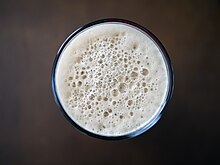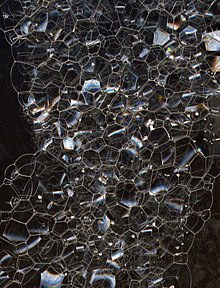This article has multiple issues. Please help improve it or discuss these issues on the talk page. (Learn how and when to remove these messages)
|



Foams are two-phase material systems where a gas is dispersed in a second, non-gaseous material, specifically, in which gas cells are enclosed by a distinct liquid or solid material.[1]: 6 [2]: 4 [3] The foam "may contain more or less liquid [or solid] according to circumstances",[1]: 6 although in the case of gas-liquid foams, the gas occupies most of the volume.[2]: 4 The word derives from the medieval German and otherwise obsolete veim, in reference to the "frothy head forming in the glass once the beer has been freshly poured" (cf. ausgefeimt).[1]: 1
Theories regarding foam formation, structure, and properties—in physics and physical chemistry—differ somewhat between liquid and solid foams in that the former are dynamic (e.g., in their being "continuously deformed"), as a result of gas diffusing between cells, liquid draining from the foam into a bulk liquid, etc.[1]: 1–2 Theories regarding liquid foams have as direct analogs theories regarding emulsions,[1]: 3 two-phase material systems in which one liquid is enclosed by another.[4]
In most foams, the volume of gas is large, with thin films of liquid or solid separating the regions of gas.[citation needed] A bath sponge and the head on a glass of beer are examples of foams; soap foams are also known as suds.[not verified in body]
Solid foams can be closed-cell or open-cell.[citation needed] In closed-cell foam, the gas forms discrete pockets, each completely surrounded by the solid material. In open-cell foam, gas pockets connect to each other. A bath sponge is an example of an open-cell foam:[not verified in body] water easily flows through the entire structure, displacing the air. A sleeping mat is an example of a product composed of closed-cell foam.[not verified in body]
Foams are examples of dispersed media.[not verified in body] In general, gas is present, so it divides into gas bubbles of different sizes (i.e., the material is polydisperse[not verified in body])—separated by liquid regions that may form films, thinner and thinner when the liquid phase drains out of the system films.[5][page needed] When the principal scale is small, i.e., for a very fine foam, this dispersed medium can be considered a type of colloid.[not verified in body]
Foam can also refer to something that is analogous to foam, such as quantum foam.[not verified in body]
- ^ a b c d e Weaire, D & Hutzler, S (1999). The Physics of Foams. Oxford, England: Oxford University Press. ISBN 0198510977. Retrieved August 30, 2024.
{{cite book}}: CS1 maint: multiple names: authors list (link) Note, this source focuses only on liquid foams. - ^ a b Cantat, I; Cohen-Addad, S; Elias, F; Graner, F; Höhler, R; Pitois, O; Rouyer, F & Saint-Jalmes, A (2013). Foams: Structure and Dynamics. Oxford, England: Oxford University Press. ISBN 978-0199662890. Retrieved August 30, 2024.
{{cite book}}: CS1 maint: multiple names: authors list (link) Note, this source also focuses on liquid foams. - ^ The general use of the term, which includes both noun and verb forms, is both narrower and broader than the one from material science described here. In general use, it is narrower, in that it most often refers to liquid foams; it is broader in that it includes all manners of such, and the actions to produce them, hence, according to Merriam-Webster, the term refers to "a light frothy mass of fine bubbles formed in or on the surface of a liquid or from a liquid", giving the examples of those produced by "salivating or sweating", ones stably produced to fight fires, ones that are the product of gas bubbles introduced during manufacturing, and then the further broad examples of sea foam, and then anything resembling the foregoing. Finally, the general definition includes actions to produce all of the above. See "Foam". Merriam-Webster. Archived from the original on December 9, 2014.
- ^ IUPAC (1997). "Emulsion". Compendium of Chemical Terminology (The "Gold Book"). Oxford: Blackwell Scientific Publications. doi:10.1351/goldbook.E02065. ISBN 978-0-9678550-9-7. Archived from the original on March 10, 2012.
{{cite book}}: CS1 maint: bot: original URL status unknown (link) - ^ Lucassen, J. (1981). Lucassen-Reijnders, E. H. (ed.). Anionic Surfactants – Physical Chemistry of Surfactant Action. NY, USA: Marcel Dekker.[page needed]